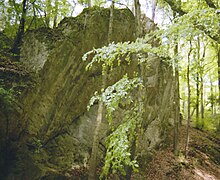Fürstenstein ruins
| Fürstenstein ruins | ||
|---|---|---|
|
Fürstenstein ruins, today's access |
||
| Creation time : | unknown | |
| Castle type : | Hilltop castle | |
| Conservation status: | ruin | |
| Place: | Ettingen | |
| Geographical location | 47 ° 28 '3.7 " N , 7 ° 31' 50.4" E | |
| Height: | 590 m above sea level M. | |
|
|
||
The ruin Fürstenstein lies on the municipal ban of Ettingen in the canton of Basel-Landschaft in Switzerland .
location
The ruin of the hilltop castle is located southwest of Ettingen or southeast of Hofstetten-Flüh at the entrance to the Wallental on a steep 590 m above sea level. NN high rock ridge. In the course of the Jura fold, the limestone layers were practically vertical in this area and in places formed a very narrow rock ridge on which one would hardly expect a hilltop castle (see picture below). The ruin is accessed from the south-eastern end of the ridge and is shown in the picture above.
investment
Only small remains of the wall have survived from the fortress, so that its entire extent is difficult to determine. 1412 is reported of an upper and a lower house . The main remains of the wall can be found at the eastern end of the rock ridge, which is a little wider. Readings indicate that the western end of the ridge was also used in some way. The still visible masonry was built from little hewn chunks of limestone. The original access led to a gate on the east side at the foot of the castle and then a steep ascent and stairs to the higher parts of the castle: a staircase carved out of the rock is visible in the picture above. On the eastern part of the ridge, which is a little wider than the rest, there was probably the main building and a tower.
The area south of the castle appears to have been artificially terraced and was probably used to erect economic buildings. In the southern wall of the ridge, washed-out holes are still visible, which may represent traces of beam holes.
Here is an excerpt from a text by the Ettingen teacher Paul Brodmann:
“The fact that there are now only a few of the once stately walls is due to the fact that the Ettingians used material there when building their houses in order to be relieved of the trouble of breaking stone. It was completely buried and the way up on it was only accessible to good climbing. In 1864 a nature lover cut a staircase into the rock from here and leveled the surface a little, so that one can now climb a little more comfortably to enjoy the honest view of the wide plains of the Leimenthales, the Birsthales and the Sundgau. "
The wall shown in the first picture is the platform installed in 1864.
history
Nothing is known about the beginnings of the castle and the motivation for its construction. The current name of Fürstenstein alone cannot necessarily be interpreted to mean that the builder was the Bishop of Basel. Since the Lords of Rotberg , with the exception of the fortress ruin Sternenberg , ruled the whole area, it is more likely that the Fürstenstein was founded by them: In 1302 the Fürstenberg is first mentioned as an episcopal fiefdom to the Rotbergers. During this time, castles and the associated rights were often handed over from the owners to a powerful ecclesiastical or secular lord to ensure their protection, and then transferred back to the original owner as a fief. In the war between King Albrecht and the Bishop of Basel , the fortress was besieged by the Habsburgs. The siege was called off after King Albrecht was murdered on May 1, 1308. The castle was damaged in the Basel earthquake , but it was quickly repaired. In 1410, the former dictatorial mayor of Basel, Hans Ludmann von Rotberg, withdrew to protect the fortress. To strengthen his position of power, he allied himself with Catherine of Burgundy , who in turn allied with Basel in 1411. Due to a feud between Catherine and Heinrich zu Rhein and Rudolf von Neuenstein, Heinrich and Rudolf attacked the Fürstenstein fortress. Basel, as Katharina's ally, then destroyed Fürstenstein Castle and beheaded Heinrich zu Rhein and the entire crew. In 1515 the ruin and the rights attached to it were sold to Solothurn, along with the entire Rotberg rule.
literature
- Werner Meyer : Castles from A to Z - Burgenlexikon der Regio . Published by the Castle Friends of both Basels on the occasion of their 50th anniversary. Klingental printing works, Basel 1981, p. 98.
- Carl Roth: The castles and palaces of the cantons of Basel-Stadt and Basel-Landschaft . Birkhäuser, Basel 1932.



